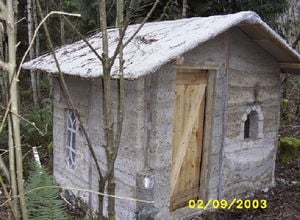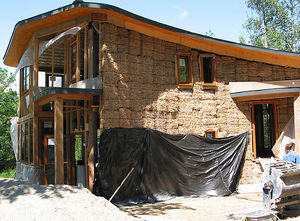No edit summary |
No edit summary |
||
| Line 30: | Line 30: | ||
Here is some [[Help:Contents#Uploading|help uploading files]]. | Here is some [[Help:Contents#Uploading|help uploading files]]. | ||
[[THE_FINAL_SPREADSHEET97. | [[THE_FINAL_SPREADSHEET97.xls[Papercrete vs. Strawbale]] | ||
== Justifications == | == Justifications == | ||
| Line 44: | Line 44: | ||
== Results == | == Results == | ||
Even though strawbale is much less energy intensive in extraction than papercrete we still chose papercrete as our building material. | Even though strawbale is much less energy intensive in extraction than papercrete we still chose papercrete as our building material. We valued and weighted the different categories and papercrete came out top on almost all of them. It won in total cost of shed which for papercrete is one tenth that of the strawbale. It won in Carbon Dioxide emissions for transportation of the material and the production. The straw bale is much larger and takes up more space than the papercrete and has a much higher r-value which we felt was irrelevant for a tool shed. Both materials have a strong tolerance to seismic activity and if the surface is covered correctly they are both very resistant to mold and rot. This was important to us for both materials since we live in Northern California in a climate that is very wet and every structure is susceptible to mold and rot. | ||
== Conclusions == | == Conclusions == | ||
Initially we had thought that Strawbale would be our material of choice because of the natural and recycled material that it is composed of but once we put the weights to what we valued most and why we were building the shed our conclusion came out differently. We spent a lot of time trying to figure out what criteria we would compare them on and we came up with were a set that take into account many different aspects of the construction and what goes into the materials we might use. We believe that the papercrete is a better choice but it may have been different if we were building a home that was much larger and could use the insulative properties. | |||
== Discussion and next steps == | == Discussion and next steps == | ||
This project and analysis could be improved and expanded upon in many ways. We only researched and analyzed two different materials, both of which are not the most common type. One way in which we would like to see this project move forward is adding typical construction materials such as wood frame, insulation and sheet rock. How do these materials stack up to the alternatives? It would be very interesting to see the embedded energy analysis or a cost benefit analysis of the materials we are most used to seeing and the alternatives to them. The purpose is to ultimately cut down on our consumption and pollution so without comparing the alternatives to what we already use than I believe we are lacking some critical information | This project and analysis could be improved and expanded upon in many ways. We only researched and analyzed two different materials, both of which are not the most common type. One way in which we would like to see this project move forward is adding typical construction materials such as wood frame, insulation and sheet rock. How do these materials stack up to the alternatives? It would be very interesting to see the embedded energy analysis or a cost benefit analysis of the materials we are most used to seeing and the alternatives to them. The purpose is to ultimately cut down on our consumption and pollution so without comparing the alternatives to what we already use than I believe we are lacking some critical information | ||
Revision as of 17:58, 15 December 2008
Sean Gavlas, Jessica Fowler, Brandon Barlow, Graham Felsenthal
Humboldt State University - Arcata, CA
December 2008


Abstract
Background
Even though we might be accustomed to only a few different types of building materials in the United States, there are many alternatives to the typical wood and sheet rock or redbrick buildings. Some alternatives are more environmentally friendly than others and more suited to certain locations, but by what factors can these decisions be made. How can they be compared? We have had the opportunity to research Papercrete and Strawbale building materials as alternatives to the typical and most common building materials. Strawbale houses were very popular among settlers in the plains areas for the abundance of straw and the insulative properties useful during long cold winters. Once the mass production of construction materials in the 1950's started strawbale construction began to lose popularity. Strawbale could not compete with the cheapness and quickness of application that the mass produced materials had, but by the 70's with the appropriate technologies movement, there was a resergence of people interested in the application of strawbale as a building material. It is a byproduct of grains harvesting and usually becomes waste. It has an amazing r-value which creates a much lesser demand for heating in the winter and cooling in the summer and can withstand strong seismic activity because of its compressive strength capabilities and flexibility.
Papercrete is a building material made from cement, shredded paper and sand. Mostly it can be made from waste paper and the mixes are variable such as the portland cement can be minimalized. The application of papercrete is versatile and can be shaped in many different forms. The sizes of the bricks can be made for different specifications and they can be made on site over a period of time.
Problem statement
The Campus Center for Appropriate Technologies (CCAT) at Humboldt State University has asked us, as students of Engineering, to research different building materials for a tool shed that they will be building on site. The shed will not only be functional, but as are almost every aspect of CCAT will be a teaching tool and demonstration piece for the community. Even though a tool shed might not need an r-value of 50 or walls
Our goal in researching these two materials is to determine which one is more suitable for our location based on a number of different comparable criteria such as transportation costs, CO2 emissions, and R-Value. Just because there is an alternative building material doesn't necessarily make it the best choice. If one material takes more fuel, creates more pollution and uses up more natural resources than another it might be wise to take another look before the decision is made.

Instructions
This is our spreadsheet which is dynamic and user friendly. It enables one to input their own information based on their specific location such as price per bale or distance of transport. After comparing the two materials one can make a qualitative decision of which material best suits their needs and is the most appropriate. The user can input information into the red colored cells such as the distance for strawbale from harvest site to construction site. Changing these values changes the cells related to them such as the amount of fuel needed for transportation of the material. The user can also go to sheet number 2 and change the weights of the different categories. If cost isn’t as important to one person as another than that weight can be modified to fit the users concerns and desires.

Here is some help uploading files.
[[THE_FINAL_SPREADSHEET97.xls[Papercrete vs. Strawbale]]
Justifications
Average straw yields for the 2003-2004 growing season were found at the University of Kentucky Spindletop Farm, Lexington, KY. This provided us the information on what the average price per bale should be- [1] Farming information including average fuel useage per acre. From this site we gathered part of the equation needed in figuring out carbon emissions- [2] Strawbale weight and dimensions , this allowed us to calculate how many bales needed per shed- [3] John Deere 8030 Series Tractors: Record-setting fuel efficiency!(15.13Hp*hr/gal. Data we used in determining carbon emissions- [4] Most comprehensive Strawbale site we've found (Great References)- Canada based site that addresses history, method, load bearing capacity, applications, and common concerns (i.e. height limitations, rot, fire, longevity...). This became most of the comparable data used against Papercrete- [5] We found the prices of strawbale from a local distributor in our town. The helped us factor in the distance that the straw travels from the harvesting site to the construction site. There was also a project in the central California that got their straw from the same area. This factor of transportation provided more information to calculate carbon emissions- [6], [7] Papercrete has numerous variables, we tried to match our information with the some of the most common forms and mixtures used for load bearing construction. This standardization allowed us to make it comparable to strawbale- we found a lot of information through living paper.com that provided how to's, mixes and instructions.[8] We also found a lot of information concerning statistics on the CO2 emissions of cement as well as graphs for analysis on papercrete. We used this as a comparison to strawbale-[9]
Results
Even though strawbale is much less energy intensive in extraction than papercrete we still chose papercrete as our building material. We valued and weighted the different categories and papercrete came out top on almost all of them. It won in total cost of shed which for papercrete is one tenth that of the strawbale. It won in Carbon Dioxide emissions for transportation of the material and the production. The straw bale is much larger and takes up more space than the papercrete and has a much higher r-value which we felt was irrelevant for a tool shed. Both materials have a strong tolerance to seismic activity and if the surface is covered correctly they are both very resistant to mold and rot. This was important to us for both materials since we live in Northern California in a climate that is very wet and every structure is susceptible to mold and rot.
Conclusions
Initially we had thought that Strawbale would be our material of choice because of the natural and recycled material that it is composed of but once we put the weights to what we valued most and why we were building the shed our conclusion came out differently. We spent a lot of time trying to figure out what criteria we would compare them on and we came up with were a set that take into account many different aspects of the construction and what goes into the materials we might use. We believe that the papercrete is a better choice but it may have been different if we were building a home that was much larger and could use the insulative properties.
Discussion and next steps
This project and analysis could be improved and expanded upon in many ways. We only researched and analyzed two different materials, both of which are not the most common type. One way in which we would like to see this project move forward is adding typical construction materials such as wood frame, insulation and sheet rock. How do these materials stack up to the alternatives? It would be very interesting to see the embedded energy analysis or a cost benefit analysis of the materials we are most used to seeing and the alternatives to them. The purpose is to ultimately cut down on our consumption and pollution so without comparing the alternatives to what we already use than I believe we are lacking some critical information
References
See Help:Footnotes for more.
- ↑ http://www.uky.edu/Ag/GrainCrops/Research/Research_pdf/SmallGrains_StrawYields2005.pdf
- ↑ http://www.precisiontillage.com/assets/uploads/Costs%20and%20Fuel%20Use.pdf
- ↑ http://www.buildinggreen.com/auth/image.cfm?imageName=images/0403/baledimensions.jpg&fileName=040301a.xml
- ↑ http://www.deere.com/en_US/ag/feature/2008/8030_fuel_efficiency.html
- ↑ - http://harvesthomes.ca/building/straw_bale_primer.pdf
- ↑ 3G’s Hay and Grain, Arcata California
- ↑ http://www.presentationcenter.org/Environment/Welcome_Center/WC_Construction/straw_bale.html
- ↑ http://www.livinginpaper.com
- ↑ http://www.buildingforafuture.co.uk/autumn05/ordinary_portland_cement.pdf
<layout name="Spreadsheet analysis" />